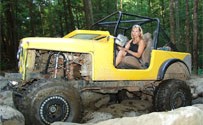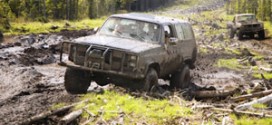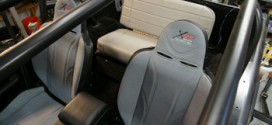
Trucks were built to haul heavy loads. Without that capability trucks would simply be – well – a silly looking car with a rough ride and bad gas mileage.
If your truck squats to its bump-stops when you load the bed with heavy goods, or hitch a heavy trailer to it, then you probably need to do something to help it out a little. While there are dozens, if not hundreds of products on the market today designed to augment a truck’s ability to haul heavy loads, most of them do so while sacrificing ride quality because to increase capacity you generally have to start by stiffening the rear suspension.
 So what’s a guy to do? Well, you can start by taking a look at Firestone Industrial Products and their Ride-Rite, Sport-Rite and Coil-Rite air helper springs.
So what’s a guy to do? Well, you can start by taking a look at Firestone Industrial Products and their Ride-Rite, Sport-Rite and Coil-Rite air helper springs.
You see, Firestone knows a thing or two about rubber products. The ones that hold air, not the ones you buy at the drug store. In fact, Firestone has been building tires since 1895, and air springs since 1934 – I’ll save you the math, that’s 73 years of experience backing their products.
So, when we decided that our ’05 Chevy Silverado HD could use a little help when hauling our heavy loads, we started our investigation by talking to the experts at Firestone Industrial Products, and with a private tour of their factory, just north of Indianapolis in the sleepy little town of Noblesville, IN.
We met with our tour guide, Paul Gibson, slipped on our safety glasses and steel-toed boots, and started our tour with a history lesson. Firestone Tire and Rubber Company started back to 1895 with the introduction of Henry Ford and Harvey Firestone, and a request to replace the bicycle tires that ol’ Model Ts were rolling on, with something that could withstand their 500 pound curb weight. From that first meeting grew a multi-national, multi-billion dollar company.
The air spring division of this global powerhouse started in 1934, and the purchase of that rubber plant in Noblesville followed shortly thereafter in 1936. The rest, as they say, is history.
Making Rubber
  After our history class we entered Rubber Making 101. Before the tour started, I imagined huge vats containing mysterious liquids boiling and cooking natural rubber into some semi-liquid-like state, but I was way off. The process of turning natural rubber (a sticky, smelly, brown substance) into Firestone’s proprietary rubber compound starts when plastic bags containing top-secret ingredients are placed on a conveyor belt, which feeds a mixer that, resembles a gargantuan roots-type blower. Everything is consumed in this mixer, including the plastic bags, which by the way, are also specifically designed to be part of the rubber compound. After our history class we entered Rubber Making 101. Before the tour started, I imagined huge vats containing mysterious liquids boiling and cooking natural rubber into some semi-liquid-like state, but I was way off. The process of turning natural rubber (a sticky, smelly, brown substance) into Firestone’s proprietary rubber compound starts when plastic bags containing top-secret ingredients are placed on a conveyor belt, which feeds a mixer that, resembles a gargantuan roots-type blower. Everything is consumed in this mixer, including the plastic bags, which by the way, are also specifically designed to be part of the rubber compound.
|
Pre-Processing
  The pressure created by mixing these items actually produces enough heat to break down the components and bond them together into the base form of Firestone’s special rubber compound. This mix is then sent to a mill, or a “calendar” as the experts call it, which is essentially a huge set of rollers that squeeze the rubber into very long sheets. These are then neatly stacked onto skids in an accordion like fashion. The pressure created by mixing these items actually produces enough heat to break down the components and bond them together into the base form of Firestone’s special rubber compound. This mix is then sent to a mill, or a “calendar” as the experts call it, which is essentially a huge set of rollers that squeeze the rubber into very long sheets. These are then neatly stacked onto skids in an accordion like fashion.
After the rubber compound is stacked it is sent to another section of the foundry where it is bound with a special top-secret fiber mesh, to create bias plies that will eventually add incredible strength to the Firestone air springs.
|
Quality Assurance – Destroying Perfectly Good Air Springs
  On the way to the assembly area, we made a detour and headed to the “Let’s-Figure-Out-Any-Possible-Way-To-Destroy-Our-Products- And-Make-Them-Better Department“. Since the sign maker charged by the letter, they shortened the name to “QA” – Corporate budgets I suppose… we like our name better. We met up with a gentlemen that has been testing products to failure for more years than I can count.. On the way to the assembly area, we made a detour and headed to the “Let’s-Figure-Out-Any-Possible-Way-To-Destroy-Our-Products- And-Make-Them-Better Department“. Since the sign maker charged by the letter, they shortened the name to “QA” – Corporate budgets I suppose… we like our name better. We met up with a gentlemen that has been testing products to failure for more years than I can count..
If there’s any one area that Firestone believes in investing money in it’s their QA department. Here we found dozens of machines and measuring devices designed to intentionally find weaknesses in products so they can be improved upon. Some of these machines were busy cycling air springs hundreds of thousands of times to see what it took to make them fail.
 In many cases, the products durability has increased so dramatically that they outlast the test equipment so it must then be redesigned to deal with the stresses of the nearly indestructible air springs. An interesting conundrum really – test the air springs to failure, improve on them immensely. Test them so much more that the machine fails, then build a better machine to wear out the air springs. Lather, rinse, repeat. In many cases, the products durability has increased so dramatically that they outlast the test equipment so it must then be redesigned to deal with the stresses of the nearly indestructible air springs. An interesting conundrum really – test the air springs to failure, improve on them immensely. Test them so much more that the machine fails, then build a better machine to wear out the air springs. Lather, rinse, repeat.
|
Assembly
 The last part of our tour focused on how the air springs are actually built, but unfortunately, the process is top-secret, and we had to put the lens caps back on the cameras. This is the section of the factory where the rubber meets the road (yeah, pun intended). Suffice to say, those bias ply rubber “sheets” that we spoke about earlier are, at this point, transformed into the various sizes and shapes of rubber compound springs, utilizing state-of-the-art equipment and specially trained personnel. The last part of our tour focused on how the air springs are actually built, but unfortunately, the process is top-secret, and we had to put the lens caps back on the cameras. This is the section of the factory where the rubber meets the road (yeah, pun intended). Suffice to say, those bias ply rubber “sheets” that we spoke about earlier are, at this point, transformed into the various sizes and shapes of rubber compound springs, utilizing state-of-the-art equipment and specially trained personnel.
During this final phase of production, one of the QA people randomly select unlucky air-springs to take back to the QA department to be tested and destroyed, all in the name of your safety and the product’s longevity.
On the drive home, I had plenty of time to ponder all that I had seen and learned that afternoon. While the Noblesville Firestone Industrial Products plant may be a bit long-in-tooth, the mixture of heritage and traditional craftsmanship coupled with state-of-the-art manufacturing technologies and relentless product-failure testing result in air springs that will most likely outlast your truck.
|
Firestone Industrial Products Co.
 |
310 East 96th Street
Indianapolis, IN 46240
Phone: 1-800-888-0650
Fax: 1-317-818-8645
Web: www.firestoneindustrial.com |

So what’s a guy to do? Well, you can start by taking a look at Firestone Industrial Products and their Ride-Rite, Sport-Rite and Coil-Rite air helper springs.

 4x4Review Off Road Magazine
4x4Review Off Road Magazine



